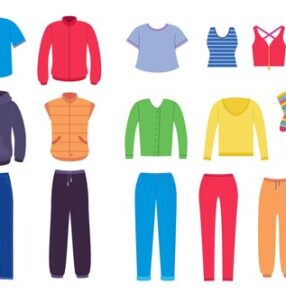
At first glance, Topper Luciani looks like the guy leading your woodland yoga retreat — with more spirit beads around his neck than a proper monk. But his actual day job is as the fashion CEO of the future, spearheading the earth-first era of fashion and flipping the vintage game on its head. Sure, selling old clothes on the internet might not sound glamorous, but it’s given Luciani a chance to support himself while helping save the planet, one used t-shirt at a time.
Luciani’s little-known first foray into the fashion world started with a polo shirt line called Sir Drake. The brand was picked up at Neiman Marcus, but ended in dramatics intense enough for a Liam Neeson film. The first problem was that Sir Drake had high manufacturing costs — costs that weren’t sustainable when the economy crashed in 2008, and sales dried up. The second (and arguably bigger) problem was that Luciani claims he’d set up shop in a factory run by the local mafia. Even with no sales, his factory costs stayed the same, naturally, and he soon learned a tough lesson about taking out credit. After dissolving his line in an attempt to dodge the debt, the mob made it clear that he still needed to pay them.
“Two men [from the mafia] cornered me in a coffee shop,” he says. “They took me into their car, drove me to a live poultry butcher shop and… let’s just say scared me into finding those funds to repay them.”
This anecdotal episode put Luciani off manufacturing completely. He turned to vintage clothing, and after experimenting with various vintage resale ventures, he came to learn about the actual lifecycle of the things we wear. Luciani realized he could do a lot more than turn a few bucks on used jackets, he could actually help reduce the ever-worsening environmental footprint of the apparel industry.
This moment of clarity led to Tagpop, Luciani’s latest venture, which is well on its way to becoming a new industry standard, changing the way we buy and value clothes, forever.

ARIEL CHANG
The current statistics surrounding clothing manufacturing are bleak. Between 1999 and 2009, the volume of textile trash rose by 40 percent in this country. Americans throw out an average of 80 pounds a clothes per year, and over 10 million tons of apparel winds up in landfills. Even if they know those stats, Luciani worries that the average consumer doesn’t care enough to change their behavior. His goal with Tagpop is to make it easier for us all to change.
“We buy our clothing from charities and clothing recyclers,” Luciani explains. “Before they can be sold off by the pound.”
Tons of clothes that seem headed for the landfill, arrive at the 8000 square foot Tagpop warehouse in New Haven, Connecticut. There, a team of stylists help Luciani to sell clothing in a way that’s never been done before: blindly. Customers can choose clothing bundles from the company website like “Mystery T-shirt Club” or “Mystery Funky Windbreakers”, and for anywhere from $5 to $25 they get a package in the mail.
Once the customer picks a product, they can include style instructions. The Tagpop team will pick out items from the warehouse using the customer’s instructions as a guide. And if the customer is not stoked on their mystery items when they receive them, they’re able to return them as many times as necessary until the Tagpop team gets it right. It’s a new vintage model, perfect for the e-commerce and subscription eras.
To test out their system, I put my own order in. I opted for the “Mystery Essentials Pack.” In my instructions, I indicated that I was going for a “Tommy Hilfiger, Ralph Lauren Christmas morning in the mountains vibe, for me and my friends.”
Here’s how Tagpop did:

KAITLYN WYLDE
Not bad, right? This must be why Luciani’s return rate is only 10%. He believes this process of “blindly” selecting items actually leads customers to a better service experience. Cataloguing fees eat up much of a company’s funding. Without the price of cataloguing, Luciani can pay his stylists to take their time sorting through premium items and do their best to make customers happy with their loot — plus, it’s kinda fun.
Part of what drew Luciani to the vintage industry in the first place was the fact that he saw a huge cost inefficiency in other vintage company’s executions. He wanted to solve the puzzle: how do you make vintage consumerism less complex? The answer, of course, was gain customer’s trust by developing a good reputation.
“I think the modern customer likes surprises,” Luciani says. “But also does not have time to sort through a ton of thrift whether those clothes are on a website or on racks.”
This is true enough. If you’ve ever spent time in a thrift store, you know that not only is it time consuming to comb through the racks, but it can also be a bit of a hellish nightmare. Second-hand stores tend to be messy, unorganized, crowded and strangely low-lit. Which is definitely a contributing factor to Tagpop’s success. People love the concept of vintage finds without the vintage grind. And for Luciani, second-hand doesn’t mean second-rate.
“I personally like used clothing more than new clothing because it tells a story,” he says. “I like things with little to no gloss. That’s why and how I’ve gravitated towards used goods.”

ARIEL CHANG
Mostly, Luciani says that his goal is to build a really big company with really happy customers — a feat he feels he’s succeeding at so far, while at the same time, growing as a person.
“As far as myself, I’ve just seen myself on first and foremost, a spiritual journey,” he says. “Pursuing this has been a weird higher calling that may sound ridiculous. It hasn’t been a higher calling to save the world or help the environment — I think of it more as this whispering internal guide.”
A guide with a pretty damn great sense of vintage style.

ARIEL CHANG
| M | T | W | T | F | S | S |
|---|---|---|---|---|---|---|
| 1 | 2 | 3 | 4 | 5 | 6 | |
| 7 | 8 | 9 | 10 | 11 | 12 | 13 |
| 14 | 15 | 16 | 17 | 18 | 19 | 20 |
| 21 | 22 | 23 | 24 | 25 | 26 | 27 |
| 28 | 29 | 30 | 31 | |||



























